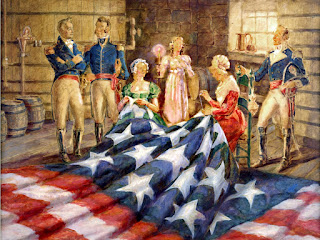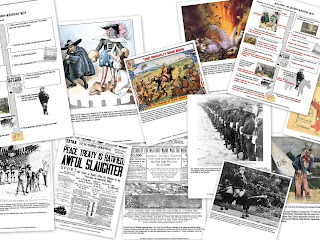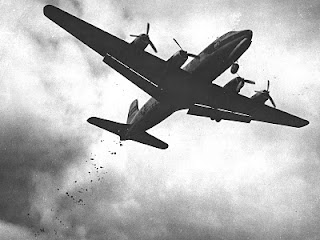American History etiketine sahip kayıtlar gösteriliyor. Tüm kayıtları göster
American History etiketine sahip kayıtlar gösteriliyor. Tüm kayıtları göster
8 Kasım 2020 Pazar
28 Şubat 2015 Cumartesi
The Strangest Battle of the Second World War
| Castle Itter in the 1970s |
The Castle And Its Prisoners:
The castle was located in western Austria in the quiet village of Itter. It was privately owned but was seized by the German Army (Wehrmacht) in 1943 for use as a prison camp under administration of the infamous Dachau Concentration Camp.
Its prisoners were rather famous VIPs who included tennis star Jean Borotra (later General Commissioner of Sports in the Vichy regime, former prime minister Édouard Daladier, Charles de Gaulle's elder sister Marie-Agnès Cailliau, former commander-in-chief Maxime Weygand, former prime minister Paul Reynaud, former commander-in-chief Maurice Gamelin (instrumental in the Phony War), right-wing leader François de La Rocque (the leader of the right-wing Croix de Feu movement), and trade union leader Léon Jouhaux.
The Battle:
On 4 May, the garrison of the castle abandoned the castle, having realised that German surrender was imminent. The French prisoners took control of the castle and armed themselves with whatever weaponry remained. A Yugoslavian prisoner, Zvonimir Čučković, was sent to find help. Zvonimir encountered elements of the American 103rd Infantry Division near the city of Innsbruck who agreed to rescue the prisoners. A defected German unit under the command of Major Josef Gangl which collaborated with the Austrian resistance and later surrendered to the Americans, agreed to accompany the rescue.
The rescue force consisted of 14 American soldiers, 10 defected German soldiers and a Sherman tank. Upon reaching the castle, the French prisoners were dismayed at the small size of the rescue but however had elected to focused on fortifying the castle in anticipation of a Waffen-SS assault on the castle. The Sherman tank was placed towards the entrance whilst positions were taken on the towers. The Allies were joined by a defected Waffen-SS officer who was recovering in the nearby village.
On the morning of the 5th, the castle came under attack from 100-150 soldiers of the 17th Waffen-SS Panzergrenadier division. Major Gangl telephoned in Austrian resistance members in the vicinity for reinforcements, 3 Austrian resistance members arrived soon after. Despite being ordered to take refuge inside the castle, French prisoners joined the battle alongside the Americans and Germans. The battle raged on for six hours, resulting in the destruction of the Sherman tank and the death of Major Gangl, before the SS were defeated by a relief force from the American 142nd Infantry Regiment.
Further reading:
US news report during the war:
2 Ağustos 2013 Cuma
Freshen Up With Archaeology Friday (Post X)
Coffin within a coffin found near Richard III site
Archaeologists have unearthed a mysterious coffin-within-a-coffin near the final resting place of Richard III.
| The coffin-in-a-coffin. (Photo from the University of Leicester) |
The University of Leicester team lifted the lid of a medieval stone coffin this week -- the final week of their second dig at the Grey Friars site, where the medieval king was discovered in September.
This is the first fully intact stone coffin to be discovered in Leicester in controlled excavations -- and is believed to contain one of the friary's founders or a medieval monk.Within the stone coffin, they found an inner lead coffin -- and will need to carry out further analysis before they can open the second box.
Archaeologists have taken the inner lead coffin to the University's School of Archaeology and Ancient History, and will carry out tests to find the safest way of opening it without damaging the remains within.
It took eight people to carefully remove the stone lid from the outer coffin -- which is 2.12 metres long, 0.6 metres wide at the "head" end, 0.3 metres wide at the "foot" end and 0.3 metres deep.
The inner coffin is likely to contain a high-status burial -- though we don't currently know who it contains.
Full article
Oldest European fort in inland America discovered in the Appalachian mountains:
 |
| The uncovered fort (Photo from the University of Michigan) |
The remains of the earliest European fort in the interior of what is now the United States have been discovered by a team of archaeologists, providing new insight into the start of the U.S. colonial era and the all-too-human reasons spoiling Spanish dreams of gold and glory.
Spanish Captain Juan Pardo and his men built Fort San Juan in the foothills of the Appalachian Mountains in 1567, nearly 20 years before Sir Walter Raleigh's "lost colony" at Roanoke and 40 years before the Jamestown settlement established England's presence in the region.
"Fort San Juan and six others that together stretched from coastal South Carolina into eastern Tennessee were occupied for less than 18 months before the Native Americans destroyed them, killing all but one of the Spanish soldiers who manned the garrisons," said University of Michigan archaeologist Robin Beck. Beck, an assistant professor in the U-M Department of Anthropology and assistant curator at the U-M Museum of Anthropology, is working with archaeologists Christopher Rodning of Tulane University and David Moore of Warren Wilson College to excavate the site near the city of Morganton in western North Carolina, nearly 300 miles from the Atlantic Coast.
The Berry site, named in honor of the stewardship of landowners James and the late Pat Berry, is located along a tributary of the Catawba River and was the location of the Native American town of Joara, part of the mound-building Mississippian culture that flourished in the southeastern U.S. between 800 and about 1500 CE.
In 2004, with support from the National Geographic Society and the National Science Foundation, Beck and his colleagues began excavating several of the houses occupied by Spanish soldiers at Joara, where Pardo built Fort San Juan. Pardo named this small colony of Spanish houses Cuenca, after his own hometown in Spain. Yet the remains of the fort itself eluded discovery until last month.
"We have known for more than a decade where the Spanish soldiers were living," Rodning said. "This summer we were trying to learn more about the Mississippian mound at Berry, one that was built by the people of Joara, and instead we discovered part of the fort. For all of us, it was an incredible moment."
Using a combination of large-scale excavations and geophysical techniques like magnetometry, which provides x-ray-like images of what lies below the surface, the archaeologists have now been able to identify sections of the fort's defensive moat or ditch, a likely corner bastion and a graveled surface that formed an entryway to the garrison.
Excavations in the moat conducted in late June reveal it to have been a large V-shaped feature measuring 5.5 feet deep and 15 feet across. Spanish artifacts recovered this summer include iron nails and tacks, Spanish majolica pottery, and an iron clothing hook of the sort used for fastening doublets and attaching sword scabbards to belts.
Fort San Juan was the first and largest of the garrisons that Pardo founded as part of an ambitious effort to colonize the American South. Pedro Menéndez de Avilés, who had established the Spanish colonies of St. Augustine and Santa Elena in 1565 and 1566, respectively, spearheaded this effort. Of the six garrisons that Pardo built, Fort San Juan is the only one to have been discovered by archaeologists.
Today's featured reading:
- Archaeologists and modern day witch doctors, by Phillip Segadika, Chief Curator at the Botswana National Museum.
8 Mart 2013 Cuma
The Surrender of Japan: A Brief Overview
| Japanese foreign affairs minister Mamoru Shigemitsu signs the Japanese Instrument of Surrender on board USS Missouri as General Richard K. Sutherland watches, September 2, 1945 |
| The USS Missouri on the day of the signing, 2 September 1945 |
| General of the Army Douglas MacArthur signing the Instrument of Surrender on behalf of the Allied Powers |
 |
| The Japanese Instrument of Surrender (click for larger image) |
The state of war between Japan and the Allies formally ended when the Treaty of San Francisco came into force on April 28, 1952. Four more years passed before Japan and the Soviet Union signed the Soviet–Japanese Joint Declaration of 1956, which formally brought an end to their state of war.
| Representatives of Japan stand aboard USS Missouri prior to signing of the Instrument of Surrender. |
19 Şubat 2013 Salı
Spanish American War Timeline Using Primary Sources
American History
group work
imperialism
lesson plan
spanish american war
US history
worksheet.
world history
Tarihçi
Comment
Our newest lesson covers the "splendid little war" known as the Spanish American War. Although brief, this war is essential for students to understand how America transitioned into becoming a world power.
In this lesson, students analyze 10 primary sources from the Spanish American War, including cartoons, newspapers, lithographs, maps, and pictures all related to each aspect of the war.
In this lesson, students analyze 10 primary sources from the Spanish American War, including cartoons, newspapers, lithographs, maps, and pictures all related to each aspect of the war.
Students then match these documents to questions along a timeline. The documents begin with a cartoon related to America protecting Cuba and move through the explosion on the USS Maine, the Teller & Platt Amendments, Rough Riders, Yellow Journalism, Buffalo Soldiers, Philippine-American War, and more.
Each task is of varying difficulty and caters to visual and kinesthetic learners in having them finishing sketches to reinforce concepts. An answer key is included and can be seen below. You can download this lesson for your classroom by clicking here. A free preview of all the documents in the lessons is available as well.
13 Şubat 2013 Çarşamba
"Uncle Wiggle Wings - The Candy Bomber " Berlin Airlift & Communism Story
American History
berlin airlift
Cold War
Germany
reading
US history
worksheet.
world history
Tarihçi
1 Comment
This lighthearted, heartwarming true story tells of American Air Force pilot Gail Halvorsen who flew supplies over Germany during the famous Berlin Airlift of 1948.
After the Soviet Union cut off Berlin from West Germany, the US plan to fly in supplies rather than break the blockade famously embarrassed the Soviet Union. This tension eventually led to the building of the Berlin Wall.
During his flights, Halvorsen would drop candy out of his plane to the children of Berlin, earning him the nickname "Uncle Wiggle Wings the Candy Bomber".
This worksheet includes one page on this fantastic story, mixing essential Common Core knowledge like the Berlin Airlift, Allied Powers, President Truman, Stalin, and more with the amusing tale of Uncle Wiggle Wings. My students really enjoyed this story and were able to relate very well to the children of Berlin.
Just the title of the story had them laughing and anxious to read it!
You can download this worksheet for your students by clicking here. An answer key is included for your convenience.
After the Soviet Union cut off Berlin from West Germany, the US plan to fly in supplies rather than break the blockade famously embarrassed the Soviet Union. This tension eventually led to the building of the Berlin Wall.
During his flights, Halvorsen would drop candy out of his plane to the children of Berlin, earning him the nickname "Uncle Wiggle Wings the Candy Bomber".
This worksheet includes one page on this fantastic story, mixing essential Common Core knowledge like the Berlin Airlift, Allied Powers, President Truman, Stalin, and more with the amusing tale of Uncle Wiggle Wings. My students really enjoyed this story and were able to relate very well to the children of Berlin.
Just the title of the story had them laughing and anxious to read it!
You can download this worksheet for your students by clicking here. An answer key is included for your convenience.
12 Şubat 2013 Salı
American Imperialism: World Leader or Bully?
American History
classroom activity
downloads
group work
imperialism
lesson plan
US history
worksheet.
Tarihçi
Comment
This downloadable worksheet combines several layers of Bloom's Taxonomy, including comprehension, analysis, and critical thinking as students review 10 US actions during the Age of Imperialism.
Included are the US purchase of Alaska, Spanish-American War, building of the Panama Canal, the annexation of Hawaii, and more. For each event, students must determine whether they feel the US was acting like a "world leader" promoting good or a "bully" acting in its own self-interest.
Whatever their decision, they must provide evidence to back up their claim. After completing the chart, students then determine whether America overall acted more like a World Leader or a World Bully and compose a short persuasive essay on their choice.
I did not include an answer key because each aspect of this is opinion-based and arguments could be made for either. However, if you would like a completed student sample, please let me know and I will supply one!
Click here to download this lesson for your student to use today!
Included are the US purchase of Alaska, Spanish-American War, building of the Panama Canal, the annexation of Hawaii, and more. For each event, students must determine whether they feel the US was acting like a "world leader" promoting good or a "bully" acting in its own self-interest.
Whatever their decision, they must provide evidence to back up their claim. After completing the chart, students then determine whether America overall acted more like a World Leader or a World Bully and compose a short persuasive essay on their choice.
I did not include an answer key because each aspect of this is opinion-based and arguments could be made for either. However, if you would like a completed student sample, please let me know and I will supply one!
Click here to download this lesson for your student to use today!










